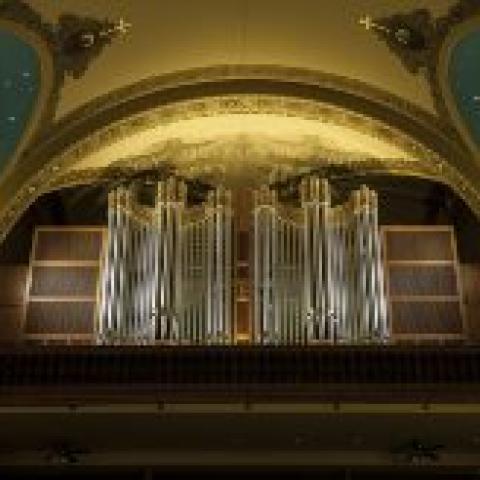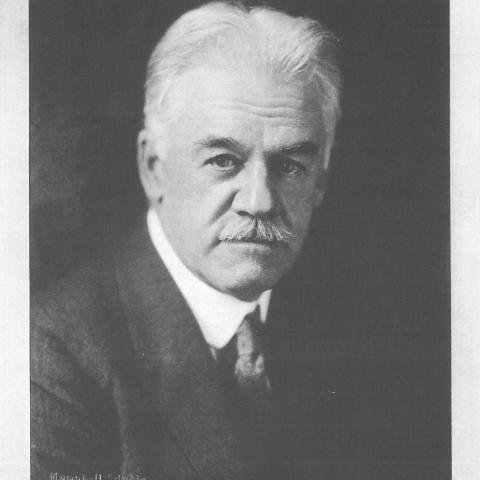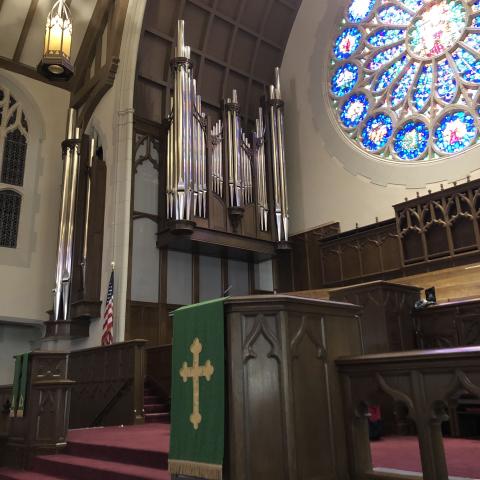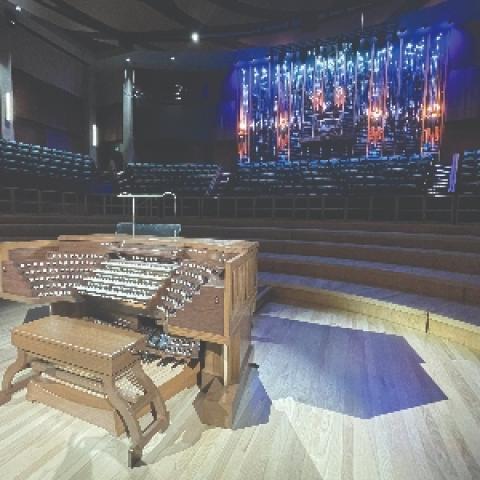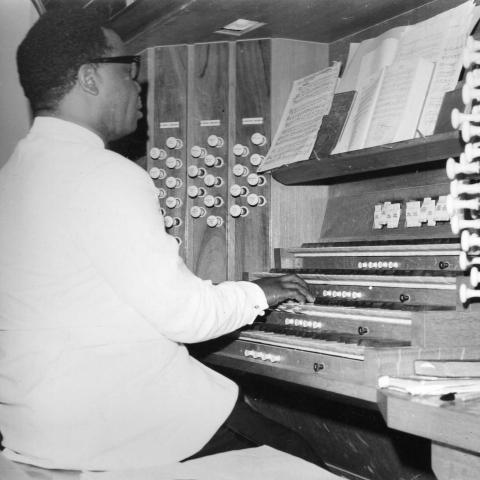Roger Sayer, a former organ student at St Paul’s Cathedral, was prizewinner at the 1989 St Albans International Organ Competition and won all the organ prizes at the Royal College of Music. His recent and upcoming highlights include recitals in Italy, Germany, Holland, and Denmark, a tour of Australia, a live recital at Temple Church broadcast on BBC Radio 3, and opening the 2018 Summer Organ Festival at Westminster Abbey. Sayer’s work as organist extends into the film world, with his most recent performance as organ soloist for Hans Zimmer’s Oscar nominated score for the motion picture Interstellar.
His latest recording, The Grand Organ of Temple Church (Orchid Classics), showcases the Harrison & Harrison Organ at Temple Church in London, UK.

The Temple Church, London, built by the Knights Templar in the late twelfth century, is set in the heart of the Inner and Middle Temple Inns of Court between Fleet Street and Embankment. The building itself comprises two distinct sections: the Round Church—a replica of the Church of the Holy Sepulchre in Jerusalem, which, according to tradition, was built over two of Christianity’s holiest places: Calvary and the empty tomb—and a rectangular church, built half a century later, which now acts as the chancel and sanctuary.
Throughout its history, the church has been home to outstanding music and musicians including organists John Stanley, Henry Walford Davies, and George Thalben-Ball. Indeed, Thalben-Ball was the first English pianist to perform Rachmaninov’s Third Piano Concerto, and famously recorded Mendelssohn’s beautiful Hear My Prayer with treble Ernest Lough in 1927, launching the church and its choir to worldwide fame. More recently, the church and its organ have been used to record the score for the 2014 science fiction film, Interstellar. The current organ is a four-manual Harrison & Harrison instrument, originally built in 1924 as a ballroom organ for Glen Tanar Castle in Scotland and installed in the church in 1954. Records show, however, that there has been an organ at the church since at least 1307. The Glen Tanar Harrison is just one of a number of fine instruments to have graced the north wall of the chancel.
Unusually for the time, the 1307 record of the Temple Church organ is quite detailed. It appears in an inventory made by the Sheriffs of London and states that “In the Great Church [are] two pairs of organs and in the quire a book for the organs and two cushions for the chanters chairs.” Ordinarily, twelfth- to fourteenth-century church accounts only record the presence of an organ, with the result that little is known about its construction beyond what can be gathered from contemporary art in manuscript illuminations and stained glass. The instruments at Temple were most likely positive organs: small, one-manual instruments with two to three stops (usually flutes at 8′, 4′, and 2′), with bellows operated either by the organist himself or by a bellows boy.
The next reference to a major organ at Temple occurs in 1683 when the treasurers of both Inner and Middle Temple commissioned a new organ from Bernhard Smith and Renatus Harris, at the time the two leading English organbuilders. On discovering that he was in fact competing for the commission and had not already obtained the contract, Smith wrote to the two Inns of Court to request that he be allowed to build his instrument in the church, rather than in Middle and Inner Halls, as planned. His request was granted but, shortly after, Harris obtained the same permission, and each organ was built on the north and south sides of the church.1 Both builders went to enormous expense to showcase their instruments, pushing the organ further than any other instrument before (Smith’s organ was the first three-manual instrument in the country) and employing highly accomplished organists to demonstrate their capabilities.
The competition drew to a close in 1688, and rumor has it that Smith and Harris both sabotaged each other’s instruments the night before the Inns’ final decision, including tampering with the reed stops and cutting the supply from the bellows to the organ. Lord Chief Justice Jeffreys made the final decision in favor of Bernhard Smith, and the organ was installed in the summer of 1688 for the sum of £1,000, an extraordinary figure for a relatively small organ. It was tuned to meantone temperament and featured a 6′ “Sadt of mettle,” thought to be a type of gemshorn and the only example of the stop in the world. A number of pipes from this organ survive in displays in the choir vestry and at the bottom of the organ loft staircase.
1685 “Father” Smith (61 notes on manuals)2
CHAIR
Gedackt wainescott 12
Hohlflute of mettle 6
A Sadt of mettle 6
Spitts flute of mettle 3
Violl and Violin 12
Voice humaine of mettle 12
GREAT
Prestand 12
Hohlflute wood & mettle 12
Principall of mettle 6
Quinta of mettle 4
Super Octavo 3
Cornett of mettle 2
Sesquialtera of mettle 3
Gedackt of wainescott 6
Mixture of mettle 3
Trumpette of mettle 12
ECCHOS [sic]
Gedackt of wood 6
Sup. Octavo of mettle 3
Gedackt of wood 12 (from c1)
Flute of mettle 6 (from c1)
Cornett of mettle III ranks (from c1)
Sesquialtera III ranks
Trumpett 12 (from c1)
Under the direction of E. J. Hopkins, organist at Temple Church from 1843 to 1897, the organ underwent a number of changes, including the addition of thirteen stops by Edmund Schulze between 1857 and 1862, and the introduction of a hydraulic engine to power the bellows. Hopkins’s successor, Walford Davies, oversaw the organ’s renovation by Frederic Rothwell in 1910, where a substantial amount of new pipework was added to the original Bernhard Smith instrument, and the console received a complete rebuild to accommodate Rothwell’s stop-key control system.3 This organ survived just thirty-one years. On May 10, 1941, an incendiary bomb fell on the Round Church during an air raid. The fire spread from the Round to the chancel, completely destroying the organ and gutting the church, with the result that it would be thirteen years before another instrument took its place.
1896 Schulze, and Norman and Beard organ4
GREAT (56 notes)
16′ Double Open Diapason
8′ Large Open Diapason
8′ Small Open Diapason
8′ Stopped Diapason
8′ Hohl Flute
8′ Viol di Gamba
4′ Principal
4′ Octave
4′ Nason Flute
22⁄3′ Twelfth
2′ Fifteenth
III Full Mixture
V Sharp Mixture
8′ Large Trumpet
8′ Small Trumpet
4′ Clarion
SWELL (56 notes, enclosed)
16′ Bourdon
8′ Open Diapason
8′ Rohr Gedact
8′ Violin
8′ Salicional
8′ Voix Celestes
4′ Principal
4′ Rohr Flute
4′ Gambette
II Twelfth and Fifteenth
IV Mixture
16′ Double Bassoon
8′ Horn
8′ Oboe
8′ Vox Humana
4′ Clarion
Tremulant
CHOIR (56 notes)
16′ Lieblich Bourdon
8′ Violin Diapason
8′ Lieblich Gedact
8′ Spitz Flute
8′ Dulciana
4′ Gemshorn
4′ Lieblich Flote
4′ Flauto Traverso
4′ Violine
III Mixture
8′ Corno di Bassetto
SOLO (56 notes)
8′ Flute Harmonique
4′ Flute Octaviante
2′ Piccolo Harmonique
8′ Tuba Mirabilis (heavy wind)
8′ Clarinette
4′ Orchestral Oboe
PEDAL (30 notes)
32′ Sub Bass
16′ Major Bass (wood)
16′ Open Bass (metal)
16′ Violone (wood)
16′ Stopped Bass (wood)
102⁄3′ Quint (wood)
8′ Principal (metal)
8′ Violoncello (wood)
4′ Tenor Solo (metal)
2′ Treble Solo (metal)
16′ Trombone (metal)
COUPLERS
Great to Pedal
Swell to Pedal
Choir to Pedal
Solo to Pedal
Pedal Octave
Swell to Great
Solo to Great
Choir Sub Octave to Great
Swell to Choir
The Glen Tanar Harrison & Harrison organ arrived by rail from Scotland in 1953. It had been built for the ballroom in 1927—its inaugural recital was given by Marcel Dupré—but after years of neglect, was gifted by Lord Glentanar to George Thalben-Ball, organist at Temple from 1923–1982. Thalben-Ball had frequently travelled to Scotland to give recitals and had admired the instrument for its power and wonderful blend of sounds, and intended the organ to retain these qualities in its new home on the north wall of the church. Due to the vast difference in acoustic—the ballroom at Glen Tanar is a magnificent but rather squat space with a wooden ceiling decorated with hundreds of antlers—a number of pipes needed revoicing to better suit the church.
The installation was completed in 1954, and services began again after the chancel’s rededication shortly afterwards. (The Round Church was rededicated in 1958.) Since then, the organ has received expert attention from Harrison & Harrison, from removing the shutters on the Pedal reeds and Solo tuba, to modernizing the action in 1976, to installing a modern piston system in 2000. The organ underwent a complete overhaul between 2012 and 2013. Most of the instrument was dismantled and taken to the Harrison & Harrison workshop in Durham, and it now accompanies services and concerts throughout the year. Despite many alterations, the organ has retained its Romantic power and color, and perfectly complements the vibrant and expressive sound of the Temple Church Choir.
2013 Harrison & Harrison organ5
GREAT (61 notes)
16′ Double Geigen
16′ Bourdon (Gt 2nd Division)
8′ Large Open Diapason
8′ Small Open Diapason
8′ Geigen (Gt 2nd Division)
8′ Hohl Flute
8′ Stopped Diapason (Gt 2nd Division)
4′ Octave
4′ Principal (Gt 2nd Division)
4′ Wald Flute (Gt 2nd Division)
22⁄3′ Octave Quint (Gt 2nd Division)
2′ Super Octave
2′ Fifteenth (Gt 2nd Division)
13⁄5′ Seventeenth (Gt 2nd Division)
IV Mixture (19–22–26–29)
III Mixture (12–19–22, Gt 2nd Division)
8′ Tromba
4′ Octave Tromba
SWELL (61 notes, enclosed)
16′ Quintatön
8′ Open Diapason
8′ Stopped Diapason
8′ Echo Salicional
8′ Vox Angelica (from FF)
4′ Principal
2′ Fifteenth
V Mixture (12–19–22–26–29)
8′ Oboe
Tremulant
16′ Double Trumpet
8′ Trumpet
4′ Clarion
CHOIR (61 notes, enclosed)
16′ Contra Dulciana
8′ Claribel Flute
8′ Lieblich Gedeckt
8′ Dulciana
4′ Salicet
4′ Flauto Traverso
2′ Harmonic Piccolo
III Dulciana Mixture (15–19–22)
16′ Cor Anglais (extra octave of pipes at top)
8′ Clarinet
8′ Tuba
SOLO (61 notes, enclosed)
16′ Contra Viola
8′ Viole d’Orchestre
8′ Viole Céleste (tuned sharp)
8′ Harmonic Flute
4′ Concert Flute
8′ Orchestral Hautboy
Tremulant
16′ Orchestral Trumpet (extra octave of pipes at top)
8′ Horn
8′ Tuba (not affected by octave couplers)
PEDAL (32 notes)
32′ Double Open Wood
32′ Sub Bourdon
16′ Open Wood
16′ Open Diapason
16′ Geigen
16′ Bourdon
16′ Violone
16′ Dulciana
8′ Octave Wood
8′ Flute
4′ Octave Flute
32′ Double Ophicleide
16′ Ophicleide
16′ Orchestral Trumpet
16′ Bassoon
8′ Posaune
COUPLERS
Great to Pedal
Swell to Pedal
Choir to Pedal
Solo to Pedal
Swell to Great
Choir to Great
Solo to Great
Choir Suboctave
Choir Unison Off
Choir Octave
Swell to Choir
Solo to Choir
Great 2nd Division on Choir
Great Reeds on Choir
Swell Sub Octave
Swell Unison Off
Swell Octave
Choir on Swell
Solo to Swell
Solo Sub Octave
Solo Unison Off
Solo Octave
Great Reeds on Solo
ACCESSORIES
8 General pistons
8 Great pistons
8 Swell pistons (thumb and toe)
8 Choir pistons
8 Solo pistons
8 Pedal pistons
General Cancel
2 Coupler pistons
Sequencer, operating general pistons
Great to Pedal reversible (thumb and toe)
Swell to Pedal reversible
Choir to Pedal reversible
Solo to Pedal reversible
Swell to Great reversible (thumb and toe)
Choir to Great reversible
Solo to Great reversible
Swell to Choir reversible
Solo to Choir reversible
Swell to Solo reversible
32′ Ophicleide reversible
Combination couplers
Great to Pedal pistons
Pedal to Great pistons
Pedal to Swell pistons
Generals on Swell foot pistons
256 general and 16 divisional memories
Balanced Choir expression shoe
Balanced Swell expression shoe
Balanced Solo expression shoe
Notes
1. www.templechurch.com/music/the-organ/the-battle-of-the-organs/.
2. http://www.npor.org.uk/NPORView.html?RI=C00923.
3. www.templechurch.com/music/the-organ/the-rothwell-harrison-organs/.
4. http://www.npor.org.uk/NPORView.html?RI=N17808.
5. http://www.npor.org.uk/NPORView.html?RI=E02047.
Organists of the Temple Church:
Francis Pigott 1688–1704
John Pigott 1704–1737 (from 1729 for Middle Temple only)
From 1729 to 1814, the Inner Temple:
Obadiah Shuttleworth 1729–1734
John Stanley 1734–1786
Robert John Samuel Stevens 1786–1810
George Price 1810–1814
From 1729 to 1814, the Middle Temple:
John Pigott 1729–1737
James Vincent 1737–1749
John Jones 1749–1796
Emily Dowding 1796–1814
From 1814, both Inner and Middle Temple:
George Price 1814–1826
George Warne 1826–1843
Dr. Edward John Hopkins 1843–1897
Sir Henry Walford Davies 1897–1923
Sir George Thalben-Ball 1923–1982
Dr. John Birch 1982–1997
Stephen Layton 1997–2006
James Vivian 2006–2013
Roger Sayer 2014–present
Source: https://en.wikipedia.org/wiki/Temple_Church
Photo: Roger Sayer at the Temple Church organ (photo credit: Chris Christodoulou)

